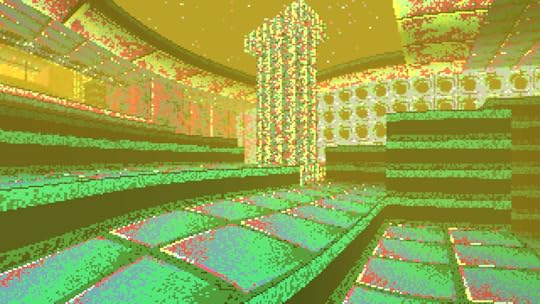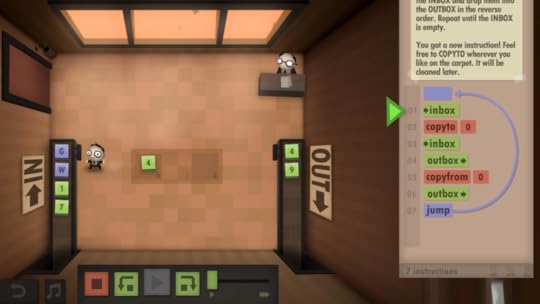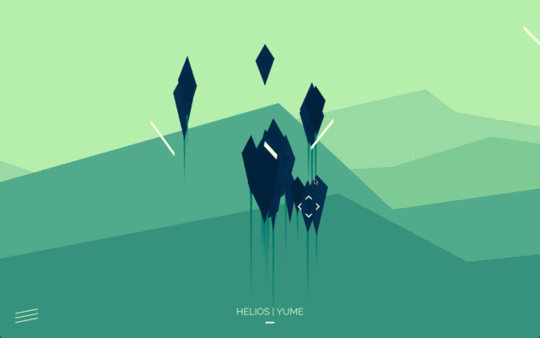Kill Screen Magazine's Blog, page 211
October 14, 2015
Knossu finds the horror in non-euclidean architecture
Knossu's wall textures sizzle as if they've been half-cooked on a frying pan. It's like someone went nuts with the spray paint tool in Microsoft Paint and the most garish colors they could find. Have you ever bitten into something that was way too sour? Imagine that vigorous and unbearable taste carved into blocks; that's what I'm staring at. On top of that, each pixel in these walls fidgets intensely as I move around and it makes me immediately uncomfortable. The impression is that I'm being stalked by something overbearing and encompassing.
This is bold opening up with a description of a wall, I know, but this is important. For this is a game about being trapped in a non-euclidean maze. There are a lot of walls. As they confront you, the instant urge is to find something easier on the eyes. You want to escape. But you can't. There seems to be no respite from this frazzled look burning into your pupils.

Jonathan Whiting, the creator of Knossu, says that it's his answer to the following question: "What can you do with a Doom style raycasting engine if you're tired of realism and shooting things?" It's also inspired by JP LeBreton's "Tourism play," in which he uses a mod to take combat out of the 1998 first-person shooter Unreal so he can focus on running through its environments. As such, Knossu is strictly about your estranged relationship with its architecture. But it's also a horror game.
the corridor you just walked down has turned into a large hall.
Before getting to that, it's worth asking why there are a handful of people still experimenting with lo-fi graphics. Lilith is one of the most interesting to watch. With Crypt Worlds and Oneiric Gardens she recalls being lost in King's Field's dungeons in her youth. She finds that the sludgy surfaces and dreamlike geometry is able to bring out raw feelings in her. You can see why. Unable to emulate realism, these early 3D worlds used bold but sparing landmarks and a grisly attention to coarseness in their textures—almost as if you're supposed to run your fingers along them—all to create a sense of place out of their abstract layouts.
Whiting uses these same techniques in Knossu. It is perhaps necessary. Every pillar, staircase, and enclosed stone room in Knossu is given its own color palette and pinch of character, and then it's turned up to 11. This is so you can recognize where you are at a glance when you're running around. Being a non-euclidean maze means that it is easy to get lost in Knossu. Turn around and, suddenly, the corridor you just walked down has turned into a large hall. This happens over and over. But that's not scary by itself. If it was then Antichamber would have been horrifying.

What you soon discover is that you're being chased by an unknowable mist of what might be glitched data that swallows you up if it gets the chance. A mist? Yeah, it doesn't read as something that would be scary. But it can be. Especially when you find yourself frantically running around in circles, unable to get out of a loop. It's something out of a nightmare I have definitely had before. The panic that Knossu can bring out in these situations is truly its greatest achievement.
Without jump scares, without screamers, without gore and weapons, it manages to find pure terror. What it does have is architecture that seems oppressive and alive and after you. It shapeshifts right before your eyes and never turns down the contrast so it's always shredding at maximum volume. When it all starts to wobble and the sound of static rings in your ears you know that mist is nearby. Perception is turned against you.
You can download Knossu for free right here.
The refreshing smallness of Secret Legend
Secret Legend is small and pleasant—and just what videogames need
Discover the computational hell of corporate work in Human Resource Machine
Tomorrow Corporation already showed an aptitude for making players do small, seemingly innocent tasks that fuel a nightmarish machine with Little Inferno. In Little Inferno, you must solve destructive puzzles by burning an unlikely array of objects to unlock more objects to be burned in their Little Inferno Entertainment Fireplace. Though progression relies on the unspeakable joy of watching something like a miniature opera singer toy explode mid belt, the story satirizes an industrial system built on waste and consumption.

Now, the team at Tomorrow Corporation is bringing their adorably dreary aesthetic to the workplace in Human Resource Machine, a puzzle game about a flesh and blood automated labor force. Arriving tomorrow, Thursday October 15th, for Windows and Mac (with a Wii U version coming the following week), the game reimagines a workplace as a machine fueled by human programmers. The gigantesque office complex represents a computer's CPU, while you provide the inputs and outputs and the slots of data storage in the center symbolize memory. Through just 11 simple commands used throughout the game, the creators claim you can simulate any algorithm in the world (and probably many the designers never thought of themselves.)
another menial promotion in your slow crawl up to corporate ladder
As a lowly programmer, you must solve the binary puzzles given to you by your fat cat boss. Of course, despite your lack of power as a programmer, you are solely responsible for making the operation run smoothly, while your boss sits back and barks orders. Each level you beat represents another year passing, and another menial promotion in your slow crawl up the corporate ladder.
While Human Resource Machine satirizes the structure and underlying principles of corporate America, Tomorrow Corporation also sees a certain elegance in the system. "Computers are really simple—beautiful and cleverly designed—but really simple things. And a modern workplace weirdly works as a pretty close metaphor for what goes on inside a CPU," Kyle Gabler told Nintendo Everything, who you might also know from the team that brought you World of Goo."

Though Human Resource Machine is first and foremost a fun puzzle game, it can also serve as a lesson in basic programming for the uninitiated. Which, as Kyle Gabler says, is a good thing because "the robots are coming. And what’s a good way to survive the invasion? Learn how to program! Stay relevant in today’s modern world! Or you will be deprecated."
In an interview for Kill Screen about Little Inferno, Gabler points out that a big part of Tomorrow Corporation's aesthetic relies on a visually limited perspective—like one room in an office building or a furnace—that allows them to "dribble in bits of a huge and wonderful and scary world that's always just out of reach." So you can rest assured that there is more to Human Resource Machine than meets the eye.
You can buy Human Resource Machine this Thursday through Tomorrow Corporation's website or wait the following week for the Wii U release.
Jotun is awesome and awe-inspiring
Jotun is what we mean when we use the word “epic.”
October 13, 2015
Future Firewatch lookouts: you now have a release date to watch out for
The mysteries fall ever closer.
Need more Panoramical? Check out this ethereal interactive journey
With new album Yume, ambient electronica musician Helios seems to recall the beauty of lazing underneath a sun-crested sky. The music soothes by letting high notes drift out to a gold horizon. It seems to lift off from the soft fringes of grass and get carried out on a hot puff of wind.
More precisely, it's a series of airy vignettes punctuated by a dozy amalgam of lightly brushed acoustic guitar, everyday sounds echoed out as percussion, and piano melodies that seem to have been recorded underwater. A tranquil reverie is conjured, and so it comes as no surprise that the title of the album is the Japanese word for "dream."
It's this imagined journey towards the ether that Luke Twyman's interactive interpretation of Yume playfully captures. He teamed up with Helios to supply an alternate way of experiencing the album, reducing it to even smaller snippets for us to explore, each one a single act in a journey starting from the Earth and flying towards the heavens.
fusion of music to the visuals evokes Panoramical
Playable in your browser, this interactive project blooms into motion as if a flower unfurling its petals. Once the whitewashed transition fades you see an aqua-green landscape in the background where mountains form as bold triangles. Up front are mysterious floating rhombuses that gesture you to move them up and down, or some in any direction, when the mouse is hovered over them. Upon acting on this invitation you discover that not only can you control different parts of the song loop but also the perspective that you have of the landscape.
This fusion of music to the visuals evokes Panoramical except it's much smaller in scope. The mountains bounce to the beat if you bring it in and a swirling electronic noise brings with it flying white lines that churn over the scene when introduced. It's almost like you're playing with a DJ's mixing deck, pushing levers and turning knobs to bring in different instruments and timbres of the same song. The difference is that you're creating an animated picture at the same time.

From this first scene you can ascend to the next using one of the rhombuses. Further in you find sky ruins, warbling triangle portals, and misty mountain peaks. At each stop you get as long as you wish to experiment with the possibilities of the soundscape before moving on, or heading back to a previous one. It's a beautiful way to experience an album that so readily lends itself to a gliding ethereal escape.
You can listen to Yume and purchase it on Bandcamp and iTunes. Play the interactive journey in your browser.
Undertale���s not as peaceful as it pretends
At once charming and incoherent.
In case you needed another JFK conspiracy, here's Pollen's
There is, as your tinfoil hat-wearing friends are likely to tell you, no shortage of conspiracy surrounding the assassination of John F. Kennedy. There are the claims about the second shooter or someone on the grassy knoll. There are shadowy figures in conspiracy lore like “dark complected man,” “badge man,” “tin hat man,” “umbrella man,” and “black dog man.” Yes, those are all real, and at least everyone can agree that men are the problem. For good measure, the 1979 House Select Committee on Assassinations—yes, that was its real name—declared that there was probably a second shooter while passing the buck on the not-at-all-insignificant matter of who that shooter might be.
Pollen definitely goes further in its retelling of events
To that long list of conspiracies, we can now add another: Mindfield Games’ Pollen, which is due for release in early 2016, posits that JFK actually lived through the assassination. Having survived this attempt on his life, Pollen’s JFK governs as if he were a changed man. Isn’t that what he is? Here’s how project lead Olli Sinerma explained the idea to Game Reactor:
In our world [the world of Pollen] Kennedy was not shot, but actually his bodyguard took a bullet. … In our world [the US and the Soviet Union] joined forces and 30 years later human beings have moved to space and we have outposts on Mars, on the Moon and one of them is on Titan. On the Saturnian moon. It's pretty much common place in Pollen that you have a job in outer space. It's something comparable to have a job at the Arctic circle. It's not totally unheard of, it's pretty common and of course it's really isolated.
And that’s just the premise!
Conspiracy theories are good fodder for fiction, provided, of course, that the wound is not too fresh. This, in other words, is not what fair game looks like:
"Yes, I have an mfa in graphic design and I'd be thrilled to create the logo for...what did you say your group was?" pic.twitter.com/ZFGnOUmjHn
— Dave Itzkoff (@ditzkoff) October 12, 2015
But JFK’s assassination? Absolutely! The event led to an entire subgenre of conspiracy films. Oliver Stone’s 1991 film JFK is an all-out attack on the 1964 Warren Commission report, which found that Lee Harvey Oswald was indeed the lone gunman responsible for the assassination. Much of this ground had previously been covered, albeit with less artistic merit, in the 1966 film Rush to Judgment. Pollen definitely goes further in its retelling of events on that day and thereafter—it does not traffic in quibbles about the identities of witnesses—but is building on a strong conspiratorial tradition.
This does not necessarily clarify what conspiracy theories are and are not fair game for games and other media—nor is it my place to set that bright line—but Pollen, for all its technology and radical storytelling, is in keeping with tradition. Whether now is really the time for Michael Bay’s Benghazi film or, heaven forbid, Benghazi: The Videogame is an entirely different question.
You can find out more about Pollen on its website.
A Special Message from Kill Screen���s Official Ombudsman
Putting the “FUN” back in “videogames”
October 12, 2015
The magical realism of Japanese author Murakami gets its own videogame
You’d think video games and magical realism would’ve found each other by now, but the pairing is still a tragically rare sight. Kentucky Route Zero is one of the few games I can name that embraces elements of magical realism without evolving into full-blown fantasy, but another project called Memoranda—also a point-and-click adventure—could soon join the list.
Memoranda is inspired by the fiction of Haruki Murakami, whose works are often set in surreal realities that find a dreamlike charm in mundanity. In Memoranda’s case, the setting and the time period may be unclear and contain dissonant elements, but most of its characters are united by one thing: loss. Whether it’s an object or even their sense of self, each character has lost something that we’ll be tasked with recovering.
reacting to the absurd with a quiet acceptance
Watching its first trailer, I’m reminded of the works of Aimee Bender as much as Murakami—sad, lonely people becoming the center of strange occurrences; reacting to the absurd with a quiet acceptance.
The folks behind Memoranda promise a playable demo within the next few days.
Learn more about Memoranda on its Kickstarter page.
Kill Screen Magazine's Blog
- Kill Screen Magazine's profile
- 4 followers



